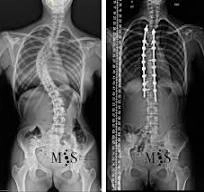
Surgical Correction of Spinal Deformity With Dr. Ahmed Mohamed
Published on: 2025-06-30 | Written by: Dr. Ahmed Mohamed Khamis, Consultant Orthopedic
Dr. Ahmed Mohamed Khamees, Consultant of Orthopedic Surgery and Fractures at Alexandria University, Member of the American Academy of Orthopaedic Surgeons, and Specialist in Joint Surgeries, Arthroscopy, and Deformity Correction, explains when spinal curvature requires surgical intervention, and outlines the most advanced and safe correction techniques used today.
What Is Spinal Deformity?
Spinal deformity, commonly known as scoliosis, refers to an abnormal lateral curvature of the spine. It often develops during childhood or adolescence and may be congenital or acquired due to muscular or neurological conditions.
According to Dr. Ahmed Mohamed Khamees, early diagnosis and careful follow-up are key to managing this condition effectively.
When Is Surgery Necessary?
Dr. Ahmed Mohamed Khamees states that surgery is considered in the following situations:
-
Curvature exceeding 45–50 degrees
-
Progression despite bracing or physical therapy
-
Significant cosmetic deformity
-
Complications affecting breathing or internal organs
-
Chronic pain or restricted daily activity
What Is the Goal of Surgery?
As explained by Dr. Ahmed Mohamed Khamees, the main goals of surgery are:
-
Correcting the curvature and restoring spinal alignment
-
Stabilizing the spine to prevent future progression
-
Protecting the spinal cord and nerve roots
-
Improving respiratory function and body posture
Modern Surgical Steps for Spinal Correction:
-
3D imaging and surgical planning
-
Minimally invasive or open surgical access
-
Insertion of metal rods and supportive implants
-
Use of specialized screws to realign and secure vertebrae
Dr. Ahmed Mohamed Khamees highlights that modern spinal surgeries are more effective, cause less pain, and ensure quicker recovery than ever before.
Surgical Outcomes and Post-Op Advice:
-
Significant improvement in posture and appearance
-
Relief of nerve-related pain
-
Boost in self-confidence, especially in teens
-
A structured rehabilitation program with stretching and strengthening exercises
-
Regular follow-up to maintain long-term success
Conclusion
Surgical correction of spinal deformity is a necessary and highly effective solution in advanced or complex cases. It greatly enhances both the functional and aesthetic quality of life. Dr. Ahmed Mohamed Khamees emphasizes the importance of early orthopedic evaluation to determine the degree of curvature and the best time for intervention. Thanks to medical advancements, spinal surgery today is safer and yields highly promising outcomes.

